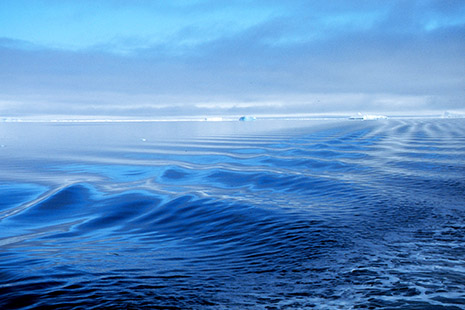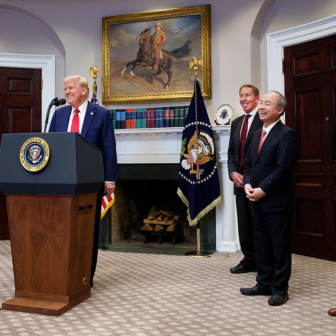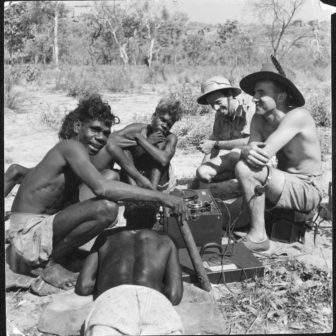FIFTY YEARS AGO this week a remarkable agreement, the Antarctic Treaty, was signed in Washington. It was created not only by strategic national politics but also by genuine idealism and – of special relevance to Australian politicians coming to terms with climate change – by a bipartisan respect for the integrity of good, international science. As we count down to the United Nations Climate Change Conference in Copenhagen, it is worth reflecting on the negotiations that led to this enduring political document.
Forged in the Cold War era, the treaty has proven to be a resilient and evolving instrument for international cooperation. Its main object is to promote the peaceful use of Antarctica and to facilitate scientific research south of 60º latitude. The key provision of the treaty (Article IV) neither recognises nor denies any existing territorial claims to Antarctica. In polar parlance, such claims are “frozen.” This political compromise emerged from a period of escalating national rivalry over Antarctic sovereignty.
In the early twentieth century Antarctica – “the last continent” – became the proving ground of nations, an additional site of European colonial rivalry, and the place for one last burst of continental imperialist exploration, which had been such a trademark of the nineteenth century. The heroic era of Antarctic exploration – associated with the names of Scott, Amundsen, Shackleton and Mawson – was “heroic” because its goal was as abstract as 90º south, its central figures were romantic, manly and flawed, its drama was moral (for it mattered not only what was done but how it was done), and its ideal was national honour.
In the 1920s, a more pragmatic geopolitics quickened in Antarctica, and the heroics down south became harder-edged and more territorial. There was, as the Adelaide Advertiser declared in 1929, “A Scramble for Antarctica” that echoed the famous “Scramble for Africa” amongst European powers in the late nineteenth century. From the 1920s, commercial whaling intensified along the edges of the ice and seven nations consistently asserted territorial claims to sectors of the continent: Argentina, Britain, Chile, France, New Zealand, Norway – and Australia, which in 1933, under the Australian Antarctic Territory Acceptance Act, formalised the transfer from Britain to Australia of sovereignty over 42 per cent of Antarctic ice.
Assertions of Antarctic possession continued to escalate and the status of claims remained unresolved – an uncertainty that became known as “the Antarctic problem.” In early 1939 an expedition from Adolf Hitler’s Germany bombed Antarctic ice with hundreds of cast-iron swastikas, each carefully counterbalanced so that it stood upright on the surface. In the early 1940s, Britain, Chile and Argentina contested possession of the Antarctic Peninsula and nearby islands. Stamps, post offices, maps and films were weapons of war in a region which, depending on your nationality, was known as Tiera O’Higgins, Tiera San Martin, Palmer Land or Graham Land. In February 1952, Argentine soldiers fired machine-guns over the heads of a British geological party trying to land at Hope Bay on the Antarctic Peninsula. The following summer, in retaliation, British authorities deported two Argentines from the South Shetlands and ordered troops to dismantle Argentine and Chilean buildings on the islands. But British and Argentine crews still had good enough relations at Deception Island to hold soccer matches, although they disagreed as to who was the home team.
Immediately after the second world war, in 1946–47, America’s great polar explorer, Richard Byrd, led the largest ever expedition south (his third), called “Operation Highjump.” The “operation” involved 4000 personnel, a dozen icebreakers and an aircraft carrier. An official Navy directive of 1946 identified the expedition as a means for “consolidating and extending United States potential sovereignty over the largest practicable area of the Antarctic continent.” In 1950, the Soviet Union announced its renewed interest in Antarctic exploration, occupation and sovereignty. It began to seem that the Cold War might find its way to the coldest part of the planet.
In 1948, the US government proposed an international trusteeship for Antarctica consisting of the seven claimant states and the United States. The apparent idealism of this terra communis was tempered by the proposal’s goal of excluding the Soviet Union from the power bloc. The claimant nations rejected the proposal because it required the renunciation of sovereignty. The Chileans, however, suggested a compromise (known as the Escudero Plan) which allowed claims to be suspended rather than renounced. By 1950 Chile and the US, united by a desire to exclude the USSR, had agreed on this revised plan for internationalisation. But a significant world event was about to change Antarctic politics.
The International Geophysical Year of 1957–58 (known as IGY) was the biggest scientific enterprise ever undertaken, and the launching of the Soviet spaceship, Sputnik, on 4 October 1957 was its most visible achievement. Building on the tradition of International Polar Years (held previously in 1882–83 and 1932–33), IGY made a focus of Antarctica as well as those other regions – outer space and the ocean floor – made newly accessible by technology. Tens of thousands of scientists from sixty-six nations took part at locations across the globe. In Antarctica, twelve countries were involved: the seven claimant nations plus Belgium, Japan, South Africa, the United States and the Soviet Union. For fifty years the main motives for Antarctic work had been national honour and territorial conquest; now, scientific work and international cooperation became the priorities.
IGY was such a resounding success that it cried out to be institutionalised. It was also clear that any management regime for Antarctica had to include the Soviet Union. Intensive diplomatic activity following IGY culminated in a draft for an Antarctic Treaty which incorporated the compromise of the Escudero Plan. Military activity and testing of any kind of weapons were prohibited south of 60º, information was to be shared, and inspections of other nations’ bases allowed at any time. On 1 December 1959, the Antarctic Treaty was signed in Washington by the twelve nations that had participated in IGY. Science as an international social system had never before revealed itself to be so powerful.
Australia argued especially for non-militarisation, freedom of scientific research and the freezing of territorial claims, with the Australian external affairs minister, Richard Casey, helping to persuade the Soviets to accept this last, crucial provision. The Russians were initially opposed to any mention of claims at all, but a meeting between Casey and Nicolai Firubin, the Soviet deputy foreign minister – held near a Queensland beach in March 1959 – brought agreement.
BY THE TIME delegates of the twelve IGY nations gathered in Washington fifty years ago, myriad working party meetings had prepared the ground for a successful conference. Yet there was still uncertainty in the air. It was not simple. The Antarctic Treaty is a relatively brief, eloquent document, but it took the momentum and euphoria of IGY, the eighteen months of working parties and then another six weeks of demanding, cooperative work in Washington to create it. And it required courage and goodwill – and some planetary consciousness – from all parties.
Participants were walking a kind of tightrope, as the leader of the French delegation explained: “Each day that went by could bring about the failure of the Conference, but each day that passed brought to us a strengthened hope of success.” And there was indeed hope and optimism in the air – and a sense of history too. Antarctic history itself was an inspiration. Delegates to the Washington conference felt a humble continuity with the courage of explorers past. As one representative put it, “we can justly feel that it is an exceptional success to have been able to conquer so many obstacles which, to us, seemed as insurmountable as those with which the daring explorers of Antarctica had to cope.”
We look back on this achievement of 1959 and see it as remarkable that such a document of peace should emerge from the period of the Cold War. They took pride in this surprising result at the time, too. In fact that anxious political context gave the meeting some of its edge and momentum. They wanted to set a new path. And people enjoyed the wordplay about temperature just as we do now: there were references to the Cold War and the need to exclude it from the coldest continent; they marvelled that a Cold Peace might break out in Antarctica; there was a lot of talk about warmth, and about thawing. The Soviet president, Nikita Khrushchev, upon assuming power in 1958, had repudiated aspects of Stalin’s regime and had been willing to travel to the United States. His visit occurred just the month before the Antarctic conference, and there were plans for President Eisenhower to visit Moscow. There was keen anticipation about a Paris summit conference in May 1960 of “the Big Four”: Khrushchev, Eisenhower, Britain’s Harold Macmillan and France’s Général de Gaulle. Détente was in the air.
And Antarctica itself delivered a lesson. In the course of the Antarctic conference, there was a fatal accident down south. A tractor carrying three New Zealanders fell down a hidden crevasse – one man was killed and two were badly injured. A US party in the area lent valuable assistance in rescuing the injured. The event was a reminder to delegates that “even in today’s conditions,” Antarctica is perilous and human cooperation is vital. The event confirmed what the delegates felt – that even as they launched Antarctica into a new political era, the physical place remained humbling and the continuities with the heroic age were strong.
It was fortunate that these crucial meetings and negotiations about the Antarctic Treaty took place in a brief period of reduced east–west tension. A major determinant for success in the treaty negotiations was that neither the United States nor the Soviet Union, having established presences on the continent, was prepared to withdraw and leave the field to the other. A few months after the treaty was signed, Soviet and American relations disintegrated dramatically when an American U-2 spy plane was captured over Russia. Eisenhower refused to apologise for the spying and Khrushchev stormed out of the Paris summit. The construction of the Berlin Wall commenced just after the first Antarctic Treaty Consultative Meeting was held in Canberra in July 1961. A year later, the world held its breath during the Cuban missile crisis. The Cold Peace, one might say, was established during a brief interglacial in the Cold War.
Today we recognise, with hindsight, that the Antarctic Treaty was not only a significant achievement in its own right, but that it was also a precursor, a model for the rest of the world and for the future. It was the first disarmament treaty of the Cold War. It became an inspiration for the governance of other places – for management of the sea and outer space. The people who created the Antarctic Treaty foresaw some of this in 1959. They believed that it could be the start of something new. This was part of the motivation, the incentive, the inspiration for what the Argentine delegate called “the transcendental provisions of the treaty.” As the leader of the Chilean delegation reported, “Someone said, during a debate, that we were drafting a document that could mean the beginning of a new era for the world.” There is this wonderful sense amongst the delegates of rising above themselves and of their nationalities, of surprising themselves with what could be achieved through sympathetic strategy and patient talk. Even the shape of the 1959 conference expressed this transformation, beginning as it did with recitations of past national achievements and ending with hopes for a common future. There were, at the end of the meeting, as the signing took place, expressions of surprise as well as extreme satisfaction. The non-nuclear provision, in the words of the Argentine delegate, went “beyond the greatest expectations.”
Remarkably, Antarctica is a part of our globe where strategic idealism has sometimes triumphed over short-term politics. Perhaps its political culture has been formed at the threshold of two ages – one of competitive nationalism and the other of cooperative internationalism. Antarctic history offers us both the latest phase of imperial partition and the first expression of planetary awareness. Politically as well as geophysically, then, Antarctica seems, as Alan Henrikson put it, “the last place on earth, the first place in heaven.” The deep black Antarctic sky with its crystal clear air really does appear to bring other worlds closer. The Antarctic Treaty – born not just in, but out of, the Cold War – is a beautiful, workable, enduring document, both delicate and robust. It truly does seem an expression of both heaven and earth. Its creation fifty years ago reminds us that politics driven by respect for science can sometimes achieve miracles. •
Photo: Tom Griffiths




